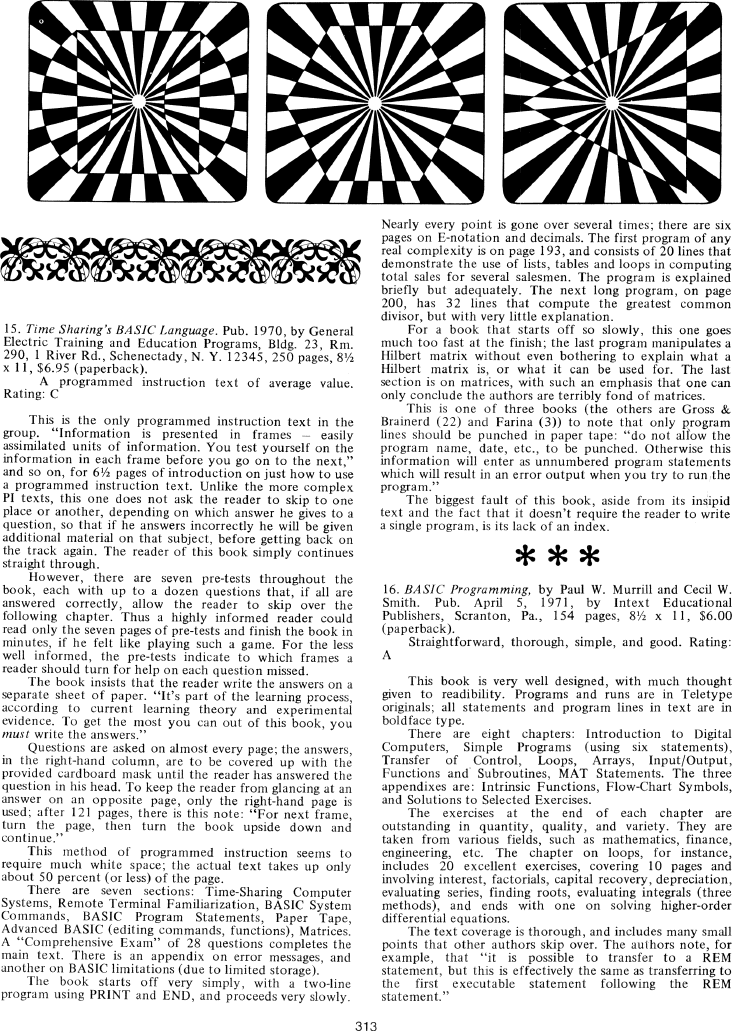The Best of Creative Computing Volume 1 (published 1976)
Reviews of 34 Books on BASIC (Time Sharing's BASIC Language, by General Electric Training and Education Programs, 1970)

15. Time Sharing's BASIC Language. Pub. 1970, by General Electric Training and
Education Programs, Bldg. 23, Rm. 290, 1 River Rd., Schenectady, N. Y. 12345,
250 pages, 8 1/2 x 11, $6.95 (paperback).
A programmed instruction text of average value. Rating: C
This is the only programmed instruction text in the group. "Information is
presented in frames - easily assimilated units of information. You test yourself
on the information in each frame before you go on to the next," and so on, for 6
1/2 pages of introduction on just how to use a programmed instruction text.
Unlike the more complex PI texts, this one does not ask the reader to skip to
one place or another, depending on which answer he gives to a question, so that
if he answers incorrectly he will be given additional material on that subject,
before getting back on the track again. The reader of this book simply continues
straight through.
However, there are seven pre-tests throughout the book, each with up to a dozen
questions that, if all are answered correctly, allow the reader to skip over the
following chapter. Thus a highly informed reader could read only the seven pages
of pre-tests and finish the book in minutes, if he felt like playing such a
game. For the less well informed, the pre-tests indicate to which frames a
reader should turn for help on each question missed.
The book insists that the reader write the answers on a separate sheet of paper.
"It's part of the learning process, according to current learning theory and
experimental evidence. To get the most you can out of this book, you must write
the answers."
Questions are asked on almost every page; the answers, in the right-hand column,
are to be covered up with the provided cardboard mask until the reader has
answered the question in his head. To keep the reader from glancing at an answer
on an opposite page, only the right-hand page is used; after 121 pages, there is
this note: "For next frame, turn the page, then turn the book upside down and
continue."
This method of programmed instruction seems to require much white space; the
actual text takes up only about 50 percent (or less) of the page.
There are seven sections: Time-Sharing Computer Systems, Remote Terminal
Familiarization, BASIC System Commands, BASIC Program Statements, Paper Tape,
Advanced BASIC (editing commands, functions), Matrices. A "Comprehensive Exam"
of 28 questions completes the main text. There is an appendix on error messages,
and another on BASIC limitations (due to limited storage).
The book starts off very simply, with a two-line program using PRINT and END,
and proceeds very slowly. Nearly every point is gone over several times; there
are six pages on E-notation and decimals. The first program of any real
complexity is on page 193, and consists of 20 lines that demonstrate the use of
lists, tables and loops in computing total sales for several salesmen. The
program is explained briefly but adequately. The next long program, on page 200,
has 32 lines that compute the greatest common divisor, but with very little
explanation.
For a book that starts off so slowly, this one goes much too fast at the finish;
the last program manipulates a Hilbert matrix without even bothering to explain
what a Hilbert matrix is, or what it can be used for. The last section is on
matrices, with such an emphasis that one can only conclude the authors are
terribly fond of matrices.
This is one of three books (the others are Gross & Brainerd (22) and Farina (3))
to note that only program lines should be punched in paper tape: "do not allow
the program name, date, etc., to be punched. Otherwise this information will
enter as unnumbered program statements which will result in an error output when
you try to run the program."
The biggest fault of this book, aside from its insipid text and the fact that it
doesn't require the reader to write a single program, is its lack of an index.
***
16. BASIC Programming, by Paul W. Murrill and Cecil W. Smith. Pub. April 5,
1971, by lntext Educational Publishers, Scranton, Pa., 154 pages, 8 1/2 x 11,
$6.00 (paperback).
Straightforward, thorough, simple, and good. Rating: A
This book is very well designed, with much thought given to readibility.
Programs and runs are in Teletype originals; all statements and program lines in
text are in boldface type.
There are eight chapters: Introduction to Digital Computers, Simple Programs
(using six statements),
Transfer of Control, Loops, Arrays, Input/Output, Functions and Subroutines, MAT
Statements. The three appendixes are: Intrinsic Functions, Flow-Chart Symbols,
and Solutions to Selected Exercises.
The exercises at the end of each chapter are outstanding in quantity, quality,
and variety. They are
taken from various fields, such as mathematics, finance, engineering, etc. The
chapter on loops, for instance, includes 20 excellent exercises, covering 10
pages and involving interest, factorials, capital recovery, depreciation,
evaluating series, finding roots, evaluating integrals (three methods), and ends
with one on solving higher-order differential equations.
The text coverage is thorough, and includes many small points that other authors
skip over. The authors note, for example, that "it is possible to transfer to a
REM statement, but this is effectively the same as transferring to the first
executable statement following the REM statement."
313


